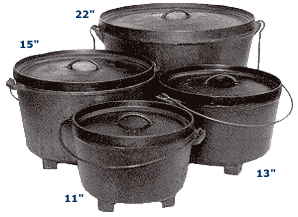|
An Introduction To Dutch Ovens by Byron Bills |
|
One of the best pieces of advice I can offer anyone looking to purchase their first Dutch oven is to select an oven that is well made. The walls of the oven should be the same thickness all the way around. Inspect the oven's bail, it should be made of sturdy heavy gauge wire and be securely attached to molded, NOT riveted, tangs on the side of the oven. Rivets can break off under a heavy load, such as when the oven is full of food. Make sure the bail is long enough that it can be lowered around one side of the oven without hanging on the lid. The bail should also stand up at a 45° angle on the opposite side which will keep the bail from getting hot, and will also offer easier access to it when positioning the oven or removing it from heat. Check the Dutch oven lid to make sure it fits tight. It should lie flush with the lip of the oven all the way around. This is to ensure that the steam created inside the oven does not escape. Make sure the lid handle is a loop attached to the lid on both ends with a hollow center so that it can be easily hooked by a lid lifter. Avoid ovens that have a molded solid tab on the lid for a handle because they are hard to lift and manage when they are loaded with coals on top. There are two basic types of Dutch ovens. The ovens I like to use are generally made of heavy cast iron, have three short legs on the bottom, and a tight fitting lid with a lip or ridge around the outer edge for holding coals and for keeping ash from falling into the food. These ovens are commonly referred to as "Camp" or "Outdoor" Dutch ovens. The second type of ovens are also generally made of heavy cast iron, have a flat bottom with no legs, and have a highly domed basting lid without an outer rim. These ovens are commonly referred to as "Bean Pots" or "Kitchen" ovens. These ovens can be used with briquettes, but their flat bottom is better suited for use on a stove top or in your kitchen oven. When selecting a "Camp" or "Outdoor" Dutch oven pay particular attention to the legs. Legs maintain the height of the oven above ground allowing air to flow around the coals beneath while cooking. Avoid ovens with short stubby legs or they may sit directly on top of the coals. Also, pay attention to the thickness of the leg where it attaches to the bottom of the oven. Some cheaper ovens have very skinny legs which can punch through the bottom of the oven when much weight is placed on them. I watched this happen at a competition once when someone stacked too many ovens on top of each other and the bottom oven collapsed!
Something else to consider when selecting a Dutch oven is the roughness of the cast metal. Some people recommend purchasing ovens with a smooth cast because they feel food won't stick to it as easily. I on the other hand have found that a rougher surface works out better in the long run. The rougher surface offers more surface area for oil to adhere to when "seasoning" the oven. As the oil builds up and hardens with cooking use it creates a very smooth surface to cook on. I have had several ovens with smooth casts "peel" when I cleaned them because the protective coating had nothing to adhere itself to. I also have had ovens that retained a nice shiny gray spot on the inside bottom because the surface was so smooth the oil could not get into the pores of the metal. Dutch ovens are manufactured by many companies today and are available in most cities if you know where to look. Outdoor sporting goods, variety, and farm and ranch stores are your best choices. I recommend buying Lodge Dutch ovens for regular cooking use, and MACA Dutch ovens when cooking for larger groups. Lodge Dutch ovens in my opinion are of better quality than some others available, but they do come at an increased price. Remember, nothing worthwhile in life comes free. MACA Dutch ovens have a thicker cast and are deeper than the Lodge ovens so they are much heavier and a bit more costly. MACA Dutch ovens can also be custom cast with your name, scout troop number, etc... on the lid. |

